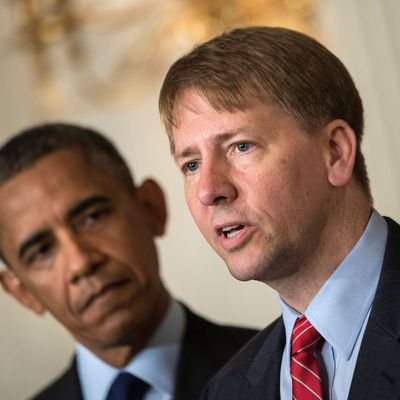
The Consumer Financial Protection Bureau, which protects consumers from being defrauded by banks, is the only agency ever designed to withstand regulatory capture by big business. Now that its director has resigned, and is attempting to pass control on to a successor who shares its mission of preventing banks from misleading and exploiting consumers, the fight its designers imagined is coming to pass. The Trump administration is going to war to turn control of the agency over to forces that wish to destroy it.
The departed director, Richard Cordray, appointed his chief of staff, Leandra English, as acting director. The Trump administration quickly announced Mick Mulvaney, its budget director, as the true director of the bureau. In a bizarre scene, both directors are attempting to manage its work and negate each other. Mulvaney has even brought doughnuts to the office.
Whether English or Mulvaney is legally entitled to run the CFPB is a legal question hinging on interpretations of competing statutes. The 1998 Vacancies Reform Act suggests President Trump can appoint whomever he wants, whereas the 2010 Dodd-Frank law, which created the bureau, states that the director can appoint his own replacement. A legal argument for English can be seen here, and a counterargument for Mulvaney here.
The political theory undergirding the design of the CFPB is that the financial industry had grown so rich and powerful that it would be generally immune to normal political control. In the wake of a crisis, people might agitate for regulation of finance, but within a few years, memories would drift, and a political balance would soon return that would allow banks to impose their will. The drafters of the Dodd-Frank law, passed in 2010 in the wake of a global economic meltdown, assumed they were seizing a rare moment when public outrage over Wall Street’s fraud and irresponsibility could override the industry’s sway.
Dodd-Frank created a wide array of reforms designed to prevent another financial crisis: new limits on leverage, transparency requirements, and regulations designed to prevent firms from growing too big to fail. One of those elements, the establishment of the Consumer Financial Protection Bureau, was also the most concrete expression of its political theory. The bureau was created because the federal government had no agency principally devoted to protecting consumers from financial fraud, even though financial products are rife with abuse. Finance is inherently complex, and sellers can easily exploit asymmetries of information, burying teaser rates and hidden fees in the fine print.
Expecting that future Congresses would try to starve the agency that cracked down on fraudsters, it was financed not through normal congressional appropriations but from transfers via the Federal Reserve. Its director was given a fixed term and could only be fired for cause — assuming, again, that a future president would seek to replace him with a lackey of the financial industry.
Republicans’ actions vindicated that assumption from the beginning. Republican senators blocked President Obama’s first choice to run the agency, Elizabeth Warren, the law professor who conceived of it in the first place, in a journal article a decade ago. Indeed, they refused to confirm any director to the agency at all unless Obama would submit to changes that weakened its powers. (”We will continue to oppose the consideration of any nominee, regardless of party affiliation, to be the CFPB director until key structural changes are made,” they threatened.) Obama only managed to appoint Cordray on a permanent basis when Democrats changed Senate rules to prevent a filibuster of an Executive branch appointment.
The agency has worked exactly as planned, impressing scholars with its ability to identify deceptive lending practices and compensate their victims. Republicans have hated it for this very reason. The 2016 Republican platform calls the bureau “the worst of Dodd Frank.” Mulvaney has called the agency he is now attempting to run a “sick, sad joke.”
During the debate over Dodd-Frank, Republicans cloaked their anti-regulatory stance in populist garb, arguing that their objection to the law was that it was too friendly to Wall Street. They have all but dropped the populist pose. The president who ran as an enemy of Wall Street now touts the Dow as his favorite metric of success while complaining big banks have been overregulated. “The Consumer Financial Protection Bureau, or CFPB, has been a total disaster as run by the previous Administrations pick,” he tweeted. “Financial Institutions have been devastated and unable to properly serve the public.” Indeed, it is nearly impossible to detect any difference at all between the official Republican line on the CFPB and the the paid stance of industry lobbyists. The author of the Trump administration’s memo arguing for Mulvaney’s position is a lobbyist for payday lenders. The author of a Weekly Standard column making the same case is also a lobbyist for financial clients who seek more lax regulation.
The Republican government is barely even pretending to be chastened by the financial sector’s pre-crisis excesses. In their mania for deregulation, and willingness to allow bankers to staff the Executive branch at the highest levels and resume their place in the right-wing cosmology as titans bestriding the globe, Trump and his allies have confirmed the fears of the reformers of the post-crash world.
The Consumer Financial Protection Bureau was designed to stop a Donald Trump — not only in the sense that he is a scammer of the sort it is trying to put out of business, but also in the sense that he represents the blend of corruption and deregulatory mania that the Dodd-Frank authors expected. Now the agency they built braces for the assault.






























